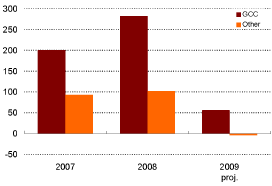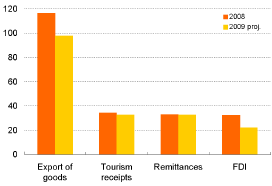Press Release: IMF Commends Middle Eastern Oil Exporter's Countercyclical Policy Response; Envisages Muted Recovery for Region's Oil Importers
October 11, 2009
October 11, 2009
Countries of the Middle East and North Africa have been hit by the global economic crisis, but the region fared better than elsewhere in the world, according to the International Monetary Fund’s October 2009 Regional Economic Outlook (REO).
Speaking on the occasion of the release of the REO, which focuses on the outlook for the Middle East and North Africa, Afghanistan, and Pakistan (MENAP), IMF Middle East and Central Asia Department Director Masood Ahmed said: “The use of reserve buffers for countercyclical spending by oil exporters mitigated the impact on their own economies and generated positive spillovers for their neighbors. The crisis has also shown the need for continued efforts to strengthen oversight to reduce the vulnerabilities of financial markets in the region.”
Oil Exporters Withstand External Shocks
MENAP oil exporters—Algeria, Bahrain, Iran, Iraq, Kuwait, Libya, Oman, Qatar, Saudi Arabia, Sudan, United Arab Emirates, and Yemen—have been directly hit by the global financial crisis through a sharp decline in oil prices and a sudden drying up of capital inflows. Lower oil production resulted in a 3.5 percent drop in oil GDP, but non-oil GDP continued to grow, though moderating to 3.2 percent. In 2010, both oil and non-oil GDP are expected to pick up to around 4 percent.
Drawing on substantial reserves built up prior to the crisis, governments responded with expansionary fiscal policies and liquidity support to their financial sectors, which have helped contain the impact on the broader economy. These policies have also helped to maintain relatively high levels of imports during the crisis, which, in turn, contributed to mitigating the global downturn. To carry out this policy approach, oil exporters drew down their reserve balances to varying degrees. As a consequence, the current account surplus of these countries dropped by nearly $350 billion (Figure 1).
|
Figure 1 Current Account Balance Shrinks (MENAP oil exporters: current account balance; billions of U.S. dollars) |
 |
|
Sources: National authorities; and IMF staff estimates and projections. |
With higher oil prices and the anticipated re-emergence of global demand, oil revenues are expected to increase, allowing oil exporters to rebuild their international reserve positions by over $100 billion in 2010. This, in turn, will provide the basis for maintaining public spending.
While most banks in the region were not exposed to toxic assets, they have been hit by the collapse in domestic asset markets and the withdrawal of foreign funds. However, prompt and forceful policy action has contained the fallout.
Looking forward, continued strengthening of financial regulation and supervision—already being instituted in some countries—will be crucial. In the medium term, financial market development—including diversification beyond a bank-based system—will remain a priority, as will efforts to improve the business climate to support economic diversification and generate employment.
Oil Importers Expect Modest Rebound
For the MENAP oil importers—Afghanistan, Djibouti, Egypt, Jordan, Lebanon, Mauritania, Morocco, Pakistan, Syria, and Tunisia—the slowdown has been less severe than in many other emerging markets, given their limited integration with global capital markets and the positive spillovers from the region’s oil exporters. The global slowdown’s main transmission channel has been a reduction in receipts from abroad (Figure 2).
|
Figure 2 Lower Receipts from Abroad (MENAP oil importers: external receipts; billions of U.S. dollars)1 |
 |
|
Sources: National authorities; and IMF staff estimates and projections. 1 Excludes Afghanistan and Djibouti. Tourism receipts also exclude Pakistan. |
While more limited in scope, countries have also responded through appropriate countercyclical policies. Growth for these countries is projected to fall from 5.0 percent in 2008 to 3.6 percent in 2009. Looking ahead, growth is projected to remain flat in 2010, mainly because of slow recovery in advanced economy trading partners and limited scope for further countercyclical policies.
High debt levels in most of the region’s oil importers limit the space for fiscal stimulus, and the scope for monetary easing will be constrained by an anticipated increase in global interest rates from current historical lows. Policymakers, therefore, need to focus more on supply-side reforms to boost private sector activity and employment, and strengthen competitiveness. In countries without fixed exchange rate regimes, greater exchange rate flexibility will facilitate these goals.
| Average | Est. | Proj. | Proj. | |||||
| 2000–04 | 2005 | 2006 | 2007 | 2008 | 2009 | 2010 | ||
| Real GDP Growth (Annual change; percent) | ||||||||
|
MENAP |
5.0 | 5.8 | 5.8 | 6.0 | 4.8 | 2.2 | 4.0 | |
|
Oil Exporters |
5.5 | 6.0 | 5.5 | 6.0 | 4.6 | 1.4 | 4.1 | |
|
of which |
||||||||
|
GCC |
5.8 | 6.9 | 5.5 | 5.0 | 6.4 | 0.7 | 5.2 | |
|
Oil Importers |
4.2 | 5.4 | 6.3 | 5.9 | 5.0 | 3.6 | 3.8 | |
| Central Government Fiscal Balance (Percent of GDP) | ||||||||
|
MENAP |
0.9 | 6.2 | 6.6 | 4.9 | 7.3 | -0.8 | 1.2 | |
|
Oil Exporters |
3.9 | 12.3 | 12.8 | 10.0 | 14.2 | 2.0 | 5.2 | |
|
of which |
||||||||
|
GCC |
5.0 | 20.6 | 22.4 | 17.6 | 27.4 | 5.3 | 10.4 | |
|
Oil Importers |
-4.6 | -5.4 | -5.1 | -4.9 | -5.8 | -5.8 | -5.9 | |
| Current Account Balance (Percent of GDP) | ||||||||
|
MENAP |
8.4 | 15.8 | 17.1 | 14.7 | 14.7 | 1.1 | 5.7 | |
|
Oil Exporters |
11.7 | 21.8 | 23.4 | 20.5 | 20.9 | 3.4 | 9.5 | |
|
of which |
||||||||
|
GCC |
12.4 | 27.4 | 28.8 | 24.8 | 26.3 | 6.3 | 14.2 | |
|
Oil Importers |
0.4 | -1.3 | -1.6 | -2.5 | -4.9 | -4.5 | -4.5 | |
|
Sources: National authorities; and IMF staff estimates and projections. | ||||||||
|
Selected Economic Indicators
| |||||||||||||||||||||||||||||||||||||||||||||||||||||||||||||||||||||||||||||||||||||||||||||||||||||||||||||||||||||||||||||||||||||||||||||||||||||||||||||||||||||||||||||||||||||||||||||||||||||||||||
IMF EXTERNAL RELATIONS DEPARTMENT
| Public Affairs | Media Relations | |||
|---|---|---|---|---|
| E-mail: | publicaffairs@imf.org | E-mail: | media@imf.org | |
| Fax: | 202-623-6220 | Phone: | 202-623-7100 | |


